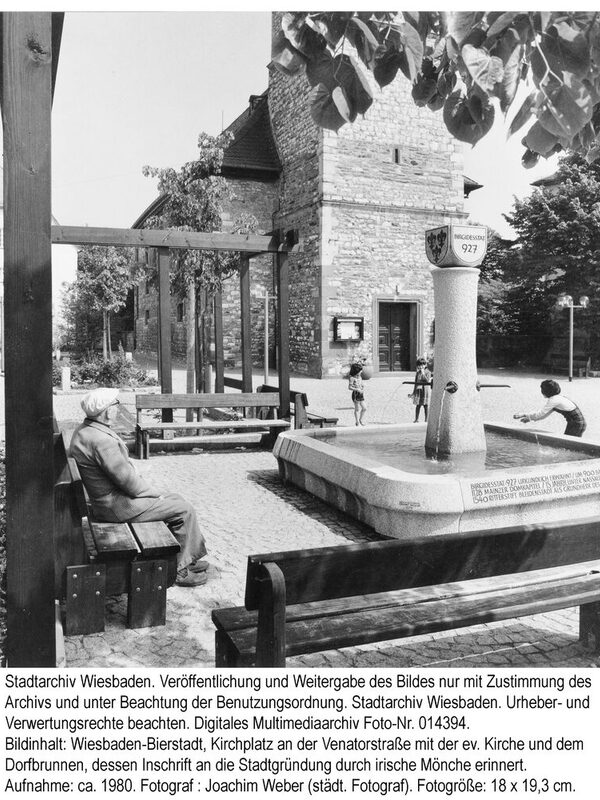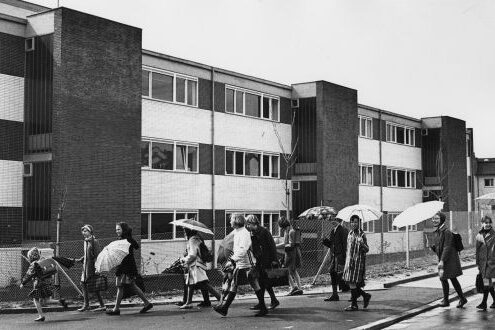Beer town
Bierstadt was first mentioned in writing in 927. The oldest surviving building is the Protestant parish church from the 12th century. In 1910, Bierstadt was connected to the Wiesbaden transport network by streetcar. Today, over 12,000 inhabitants live in the district, which was incorporated in 1928.
Bierstadt was conveniently located on the Roman road running from Wiesbaden via Igstadt and Hofheim to Frankfurt and the so-called Petersweg, which passed close to the west of Bierstadt and connected Kastel with several mountain paths over the Taunus. There are traces of settlements dating back to the earliest and later Stone Age. The remains of a Roman "villa rustica" were excavated southwest of the Theodor Fliedner School in 1846. In the area of Limes-, Bierstadter- and Wiesbadener Straße, Merovingian-era terraced graves were found.
Bierstadt was first mentioned in a document in 927 at the latest, as "Birgidesstat", located in the Königssondergau. Originally, the Ursula Monastery in Cologne owned Bierstadt, and from 1128 the Mainz Cathedral Chapter. Its property rights extended as far as Kellerskopf and Hohe Kanzel and also included the land on which the Nassauers built their Sonnenberg Castle (1221). Many religious institutions had possessions in Bierstadt, such as the Gnadenthal and Tiefenthal nunneries, both of which owned monastery farms in Bierstadt. Until the end of the 18th century, almost all the important Mainz abbeys and monasteries as well as the major knightly orders also had estates here. Jurisdiction was exercised by the Lords of Eppstein and the Schultheiß, who was appointed by Mainz Cathedral Abbey, was the civil administrator. In 1441, Nassau was able to seize the judicial rights. Around 1500, there were protracted disputes between Nassau and the Mainz cathedral chapter. The watchtower erected by Count Johann II of Nassau in 1473 still bears witness to this. An image of the tower is part of the court seal introduced around 1600. In 1519, the plague raged in Bierstadt, among other places, and the population declined. In 1525, the community took part in the Peasants' War.
In 1540, the Mainz cathedral chapter exchanged its possessions in Bierstadt with Bleidenstadt Abbey, which had been converted into a secular knightly monastery in 1495, for properties on the left bank of the Rhine. This also gave Bleidenstadt the right to appoint the parish priest, which it still exercised in 1693, even though the parish priests had belonged to the Augsburg denomination since 1561. The Bleidenstadt monastery estate in Bierstadt included 157 acres of farmland, 20 acres of meadows, timber rights and tithing rights, making it the most important ecclesiastical property in the village. The monastery was secularized in 1801. The Stiftshof fell to the sovereigns, who gave it to their minister of state, Ernst Franz Ludwig Freiherr Marschall von Bieberstein.
Bierstadt converted to the Reformation in 1550 at the latest, and a school was established in 1576. The teachers also had to ring the bells and acted as organists. Lessons were initially held in the parson's room. In 1594, a schoolhouse was built at the expense of the parish, and around 1715 the school was moved to the town hall, which was probably built in 1553. In 1819, the building was rebuilt and two classrooms were set up on the upper floor. In 1846, Bierstadt was given a new school building, later known as the "old school". A new town hall was built in 1886. In 1899, a new school was built on Hofstraße, followed by the construction of today's Hermann-Löns-Schule on Poststraße in 1906/07.
The oldest surviving building in Bierstadt is the Protestant parish church from the second quarter of the 12th century. The old farmsteads in Bierstadt, especially some in Raiffeisenstraße (formerly Langgasse), point to Franconian influence. They show a closed construction with a large courtyard gate, residential building, barn, stables and a courtyard in the middle. Two historically particularly important courtyards are the former Bleidenstadter Hof, a stately building whose rear part - the Stollhaus (Frankenhof) - dates back to the 17th century, and the Lindenthaler Hof, which was the seat of the nobles of Wiesbaden in the 13th century.
During the Thirty Years' War, Bierstadt and its population were severely affected and many people lost their lives. Around 1650, 17 families were still living in Bierstadt In the following years, the population increased again. In 1746, Bierstadt had 493 inhabitants, 100 years later 1,085 and in the middle of the 20th century 7,000 inhabitants. During the Revolutionary Wars (1792-1802), the population suffered at the hands of "Imperial, Prussian and French troops", who took up residence in the vicarage and robbed the population of all their food.
Catholics have been living in Bierstadt again since around 1780. They founded their own parish in 1907; previously they had formed a joint parish with Sonnenberg. The Catholic church of St. Birgid was built in 1938/39. It was given its present appearance in 1963. Jews were first mentioned in Bierstadt in 1540. The Jewish community built its house of prayer in Rathausstraße (now Poststraße 5) in 1827. In 1890, the Jewish cemetery was built on Kloppenheimer Straße In 1908, the Jewish community hired its own teacher. In 1927, the synagogue was renovated and solemnly inaugurated on the occasion of its 100th anniversary.
For centuries, shepherding and linen weaving were of great importance in Bierstadt alongside agriculture. Around 1750, the shepherds, and later also the linen weavers, formed their own guild. At the beginning of the 19th century, 25 citizens were engaged in the linen weaving trade. Wine was also cultivated. Over the course of the 20th century, the farming village of Bierstadt developed into a workers' and craftsmen's suburb. In the first half of the 20th century, there were two brickworks, the Buchhold and Keller piston ring factory and the pharmaceutical factory of pharmacist Adam Herbert.
At the end of the 19th century, far-reaching changes began, such as the first land consolidation (1870). The first postal agency was opened in 1884 and a new town hall was built in 1886. Today it serves as the administrative office for the eastern districts of Bierstadt, Erbenheim, Heßloch, Igstadt and Kloppenheim. In 1904, the water and gas connections were connected to the Wiesbaden mains system, followed by the connection to the Wiesbaden electricity grid in 1907. A rich club life developed: the "Frohsinn" choral society was founded in 1859, the gymnastics club in 1881, a men's choral society in 1883 and the "Frisch Auf" workers' choral society in 1898. The Bierstadt Cycling Club and the "Solidarität" Workers' Cycling Association were founded in 1900 and 1903 respectively. Two carnival clubs, a reading club, the volunteer fire department and a craftsmen's and tradesmen's association were also founded around 1900. 34 associations are currently united in the community of interests of Bierstadt's local associations. Biestadt was connected to the Wiesbaden transport network on March 19, 1910 with the establishment of a streetcar line.
173 Bierstadt residents fell victim to the First World War. A war memorial erected in 1927 commemorates the fallen. The end of the war was followed by a harsh period of occupation; 486 occupying soldiers had to be fed by the people of Bierstadt at times. On October 24, 1923, there were also clashes in Biestadt between separatists, French occupation forces and Bierstadt citizens defending the town hall. On 01.04.1928, Bierstadt was incorporated into Wiesbaden.
The last democratic elections of the Weimar Republic on March 5, 1933 brought the NSDAP victory with 1,500 votes, which they celebrated with a spectacular freedom party on the Wartturm grounds. On March 14, 1933, the swastika flag was hoisted on the Bierstadt town hall. Shortly afterwards, the boycott of Jewish businessmen, doctors and lawyers began. Clubs and associations were "brought into line" (51% of board members had to belong to the NSDAP). On the night of November 9/10, 1938, the synagogue was destroyed. Around 25 Jewish Bierstadt residents were murdered. During the heavy air raid on Wiesbaden on the night of February 2 to 3, 1945, numerous houses were destroyed.
After the end of the war, many refugees, displaced persons and American occupation troops came to Bierstadt, including over 1,250 Sudeten Germans from Teplitz-Schönau and the surrounding area alone. New houses and housing estates were built around the old town center. By 1950, the community had grown to 6,342 inhabitants. The sewerage system was extended from 1955 onwards. New school buildings became necessary, the last of which was the Theodor Fliedner School, inaugurated in 1965. In the 1960s, the Wolfsfeld housing estate was built for 3,500 residents.
Literature
1075 years of Bierstadt. 927 to 2002. Commemorative publication for the 1075th anniversary of Bierstadt in 2002. State capital Wiesbaden, local administration Wiesbaden-Bierstadt (ed.), Wiesbaden 2002.

